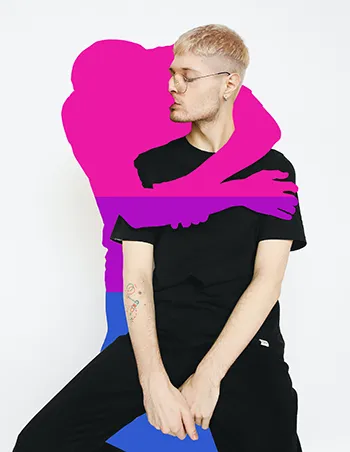After exclusively dating men and secretly making out with girls for the majority of my life, I finally decided to come out and embrace my Bisexuality at age 22 after I got out of a disastrous heteronormative relationship. There were numerous other factors that stalled this milestone, including internalized biphobia and the double discrimination that Bisexuals experience from both the heterosexual and Queer communities.
But when I finally was ready to shout "I am Bi!" from the rooftops, I was faced with a plethora of new challenges related to biphobia that I had yet to experience, especially given that I was in a long-term relationship with a man.

"People particularly struggle to read people as Bisexual if they are in a long-term relationship with one person. This means that, in a sense, once people are married, the gender of their partner is indicative of their 'real' sexuality," according to Julia Shaw, author of Bi: The Hidden Culture, History, and Science of Bisexuality. (1) This stereotype, paired with the rise in consensual nonmonogamy (romantic relationships in which all partners allow for sexual, romantic, and/or emotional relationships with others), has created pressure for Bisexuals to "prove" their sexuality beyond just coming out.
I too have found myself wondering if I can still be Bisexual if my partner and I don't regularly engage in threesomes with other women (something that is also a stereotype of Queer people). Thanks to lots of therapy and open dialogue with other Bisexuals, I know that my misconception is just that.
The truth is, whether you have sex with tons of people of the same gender or not, your Bisexuality is still just as valid, although it does create challenges for Bisexuals who are looking for ways to explore and express their sexuality without also challenging monogamy at the same time.
This is crucial because, as Julia Hartman-Linck, scholar, feminist activist, and author of "Keeping Bisexuality Alive: Maintaining Bisexual Visibility in Monogamous Relationships" (2) writes, "Being visible as a Bisexual woman was important not in terms of being recognized by potential sexual partners, but rather being recognized for who they 'are,' for their authentic selves."
Luckily, there are plenty of ways for Bisexuals to keep their sexuality alive when they aren't behaviorally Bisexual. Here are a few ideas:
Notes:
1. Shaw, J. (2022). Bi: The Hidden Culture, History, and Science of Bisexuality. Abrams Press.
2. Hartman-Linck, J. E. (2014). "Keeping Bisexuality Alive: Maintaining Bisexual Visibility in Monogamous Relationships." Journal of Bisexuality 14(2), 177–93. https://doi.org/10.1080/15299716.2014.903220
Isabel Mata is a full-time lifestyle and wellness writer whose work has been published in more than 50 outlets across the world. She is also the host of "Being Yourself Loudly," a Queer podcast destigmatizing mental illness. Connect with Isabel on Instagram at https://www.instagram.com/isabelcalkinsmata


